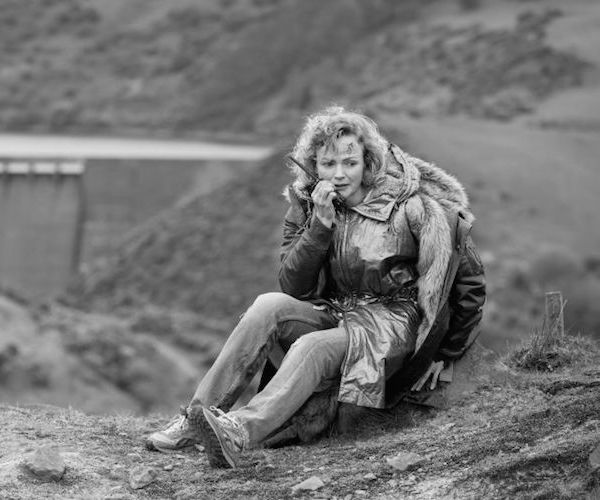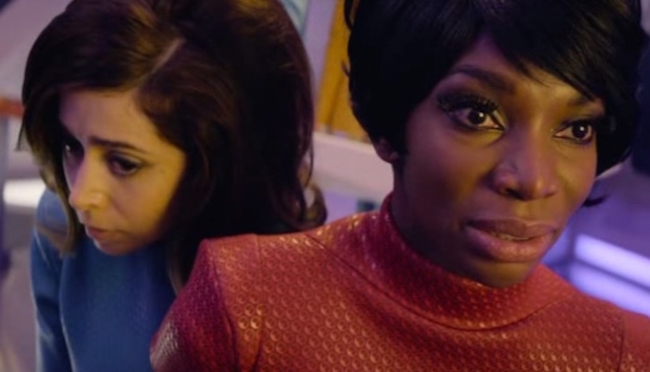WATCH CLOSELY: “Black Mirror” — Reflecting Our Dark Days
What has Black Mirror been good for, beyond entertainment, if not drawing our attention to the social and technological perils that continue to escalate around us?

Maxine Peake in “Metalhead.”
By Peg Aloi
My first encounter with Black Mirror, the British anthology series that premiered in 2011, came after a recommendation from one of my media studies students. It had not yet made it to Netflix, but was mainly distributed by BBC4. He got me a link online, and I watched the first episode, “The National Anthem” (an episode that later became enmeshed in a truth-is-stranger-than-fiction revelation about Prime Minister David Cameron). I was blown away: my love of dystopian storytelling, my anxiety about technology, my appreciation of British culture, twined in terrifying synchronicity.
As word spread, this excellent series garnered widespread critical acclaim, fueling hype pieces by the likes of Indiewire and Buzzfeed. The notion of an “anthology series” (something not seen since the days of Twilight Zone and similar fare, where no episodes are related other than by general thematic elements) gained traction also. Oddly, American Horror Story has been referred to this way, despite the fact that its structure is more like a traditional series with self-contained seasons, as opposed to stand alone episodes. They’ve begun a second franchise with Feud: Bette and Joan (Davis and Crawford), which got rave reviews; next up, or so we hear, Feud: Charles and Diana.
Now in its fourth season, Black Mirror (helmed by Charlie Brooker) has expanded its purview beyond UK-based settings and included some American-centric stories, featuring familiar TV and film actors like Jon Hamm, Rosemarie Dewitt, and Jesse Plemons. Since the first season the show had utilized top-shelf British performers like Lindsay Duncan, Rory Kinnear, Lenora Crichlow, and Michael Smiley. Ironically, despite a fairly diverse casting policy and frequent portrayal of mixed race couples, the show has yet to utilize any people of color in the director’s chair. Only recently has the all-male directing cabal been pierced by a woman (Jodie Foster), and only two women have writing credits (American actress Rashida Jones and Konnie Huq, Brooker’s wife). Given some of the controversial material in this season regarding race, sex and gender, it will be interesting to see if a more diverse coterie of creators will emerge going forward.
(I don’t plan on including any spoilers, but I’ll give a warning here just in case anything I write from this point on is too revealing. I’ve listed the episodes in order.)

Cristin Milioti and Michaela Cole in “USS Callister.”
USS Callister: The first episode is a Star Trek-inspired parody that dovetails ingenuity and dark humor. Jesse Plemons (Breaking Bad, The Post) is a poorly socialized tech genius who gets little respect at the office, but back home he has created an alternate universe where he’s a rugged Captain Kirk-like figure who bests the aliens and scores with the women: the hitch is, he has managed to reproduce digital-DNA hybrid copies of his co-workers, who feel trapped in this crazy universe. Since Black Mirror is more speculative fiction than science fiction, the exact manner in which this set-up is possible seems to be beside the point, but those more computer-savvy than I would probably make sense of it. Directed with appropriately deadpan humor by Toby Haynes (Jonathan Strange & Mr. Norrell), the epsiode’s brilliant art direction and hilarious homage to Star Trek (here called Space Fleet) as well as other pop culture references (including a nod to Netflix) gets the season off to a great start.
Arkangel: Part cautionary tale of helicopter parenting, part brutal coming-of-age tale, this story directed by Jodie Foster (who has helmed several films with prominent mother-daughter dynamics) features Rosemarie Dewitt (Mad Men, La La Land) as a single mother whose young daughter almost goes missing as a toddler. To keep Sarah safe, Mom invests in a tablet and software that shield her daughter from all dangerous or possibly upsetting sights or sounds (like barking dogs, profanity, porn). As Sarah gets older, her sheltered existence causes problems, and Mom discontinues using the system. But when her teenage daughter (now played by Brenna Harding, a fine young Australian actress) starts experimenting with sex, Mom starts hovering again, vicariously seeing and hearing things she shouldn’t, misunderstanding them (as Moms do), and taking extreme actions, like barring Sarah from seeing her boyfriend (Bloodline‘s Owen Teague). (Note: the ensuing plot point generated controversy regarding its portrayal of women’s reproductive rights.) With so many of our young people currently medicated for anxiety disorders, and living their lives attached to their smartphones, it’s natural that Brooker would peer into the crucible that is modern parenting, positing a future where no child can be truly protected from harm — but not for lack of trying.
Crocodile: This harrowing and rather violent tale follows a young woman named Mia (a riveting performance from Andrea Riseborough, also seen in Bloodline as well as Birdman) who becomes involved in a crime scene cover-up. Years later, happily married and working as a prominent architect, the crime haunts Mia and drives her to drastic measures to keep it a secret. A young insurance claims adjuster (Shazia, played by Kiran Sonia Sawar), also a wife and mother, makes use of a radical technology that allows her to access peoples’ memories, helping her reconstruct accidents. When Mia is coincidentally a witness at one such scene, Shazia’s attempts to interview her are overshadowed by Mia’s guilt and fear of discovery. Directed with merciless energy by John Hillcoat (The Road).

Georgina Campbell and Joe Cole in “Hang the DJ.”
Hang the DJ: Its title a reference to a popular 1980s song by The Smiths, this episode is a clever take on computerized dating apps. In this brave new world, couples who pair up on dates receive an expiry date on their budding relationship, which may range from hours to years. New to this dating sytem, Frank (Joe Cole, from Peaky Blinders) and Amy (Broadchurch’s Georgina Campbell) instantly like one another, but don’t question the 12 hour limit placed on their relationship. Thrown together repeatedly, they start to wonder if the computer’s match-making algorithms might be wrong about them. Romantic and well acted, this upbeat yet thought-provoking episode was my personal favorite of the season, directed by TV veteran Timothy Van Patten (Boardwalk Empire, The Sopranos, The Wire, Sex and the City).
Metalhead: Filmed in black and white on the Scottish moors, and with one actor carrying 95% of the story, this is a tour de force of atmospheric cinematography and brilliant special effects. David Slade (American Gods, Hannibal) directs this post-apocalyptic tale of a world overrun with mercenary dog robots, programmed to kill their quarry with deathly-accurate capability. Prolific stage and TV actress Maxine Peake plays Bella, on a mission to procure a mysterious item from a warehouse meant to help a sick child. She and her two companions are set upon by one of the “dogs” and Bella must continue alone, forced to outsmart the relentless metal beast. In this threatening, cruel landscape, one assumes Bella is risking all to obtain medicine, but the reveal underscores the small comforts that become important in a world under siege.
Black Museum: Beginning with Season 2’s White Christmas and last year’s Hated in the Nation (the episode that seemed to finally cement show’s popularity, thanks to a flurry of social media praise), the season finales are the longest and most complex episodes, and Black Museum (directed by Sherlock’s Colm McCarthy) is no exception. It is an intricate, horrifying story, not for the faint of heart, and begins with a young woman named Nish (Letitia Wright, soon to be seen in Black Panther), on a road trip in an immaculate vintage Thunderbird, who stops at a remote gas station in the desert. Nearby is an innocuous, functional looking building with a sign proclaiming it to be “The Black Museum.” The car and the deserted gas station feel timeless, yet we know the story is set in the present or the very near future.
The protagonist is an African-American woman, who is alone. The museum’s sole employee is a white man, and the desolate surroundings hint at imminent danger. Showing Nish around the museum, proprietor Rolo Haynes (Penny Dreadful’s Douglas Hodge) talks like a used car salesman, but he uses sophisticated tech terms to describe the museum’s artifacts. The narrative that links the displays together revolves around a doctor who agrees to use an implant, developed by Haynes’ company, that allows him to feel the physical sensations that his patients feel, enabling him to obtain expert diagnostic results and becoming a legend in the medical industry. But, Haynes explains, the doctor’s experiences feeling others’ pain and fear become addictive and eroticized. A creepy enough story, but why is Haynes in the middle of nowhere if his product was so revolutionary?
Something is wrong here. The museum’s relics are gruesome: preserved body parts, remnants of suicides, and the portrayal of various medical experiments, Nish keeps her distance from Haynes, who seems to grow more agitated by the minute. The name of the museum isn’t explained until fairly far along in the story, by which time thoughts of the horrific Tuskegee study have arisen unbidden. An African-American man wrongfully executed for murder (convicted of a crime he did not commit) is at the center of the last horrific gallery. His misfortune was exploited by Haynes. I was reminded of the series’ first season episode, White Bear, in which Lenora Crichlow, the sole black character, is manipulated and tortured by an entirely white cast of characters, punished for a crime she was guilty of. I don’t know if this inverted parallel was intentional, but it made me consider the episode’s racially-charged implications.
And that brings me to the meta issue surrounding this episode; what has Black Mirror been good for, beyond entertainment, if not drawing our attention to the social and technological perils that continue to escalate around us? As a white viewer and writer, I was intrigued to see a call on social media for editors to assign black writers to critique this episode. I think this is a fair request; I’ve been well aware for years now that media criticism is pretty well dominated by white males. Efforts in recent years to redress this imbalance in other parts of the entertainment industry are spreading, but increased representation of previously disenfranchised people (whether because of race, gender, religion, or sexual orientation) falls short of genuine change if the people critiquing these works of art are themselves representative of the old guard.
As a female film critic, I’ve hit my head on the glass ceiling more than once, or at least been made to feel self-conscious in the overtly male milieu of film criticism. Television criticism, happily, seems to be a field where female writers have excelled, led by some fearless mavericks at Salon (Laura Miller, Joyce Millman, Heather Havrilesky, Stephanie Zacharek, I’m looking at you). Television grows more artful and cinematic by the day, encouraging more complex criticism. But, as a white critic, I feel and know we must do better to encourage racial diversity in this field, if it is to continue to flourish and grow.
Peg Aloi is a former film critic for The Boston Phoenix. She taught film and TV studies for ten years at Emerson College, and currently teaches at SUNY New Paltz. Her reviews also appear regularly online for The Orlando Weekly, Cinemazine, and Diabolique. Her long-running media blog “The Witching Hour” can be found at themediawitch.com.
